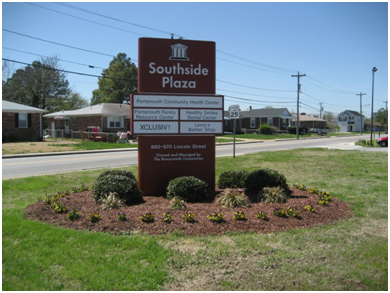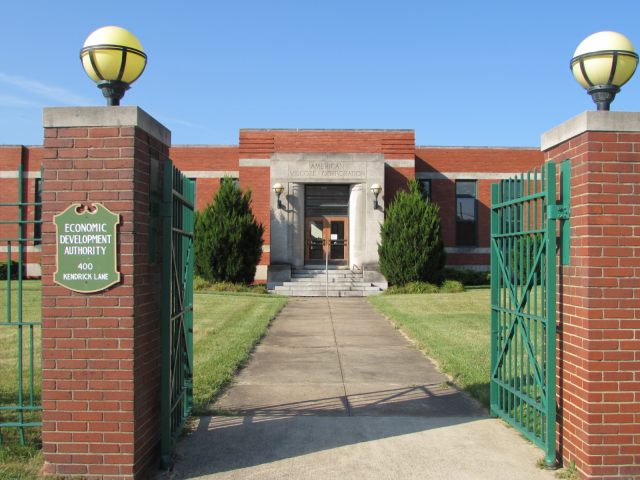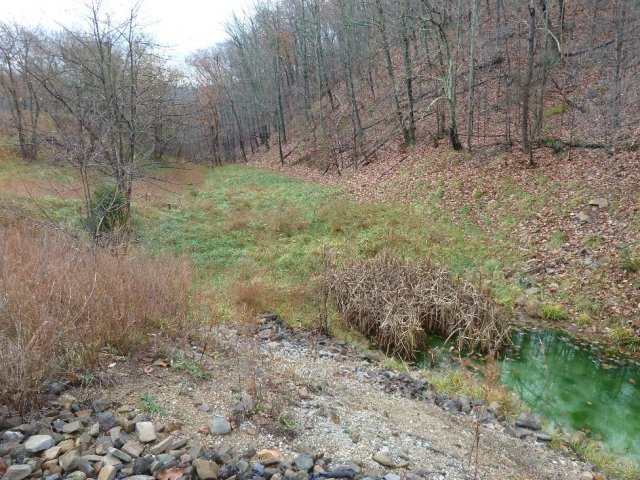Superfund Sites in Reuse in Virginia
If you are having trouble viewing the map in your browser, click the 'View larger map' link below
ABEX CORP.

The Abex Corp. Superfund site is in Portsmouth, Virginia. The Abex Corporation/Railroad Products Group (Abex) ran a brass and bronze foundry on-site from 1928 to 1978. It recycled used railroad journal bearings and recast the metal to make new bearings. The disposal of foundry waste sands and emissions from the smelting furnaces contaminated site soil, surrounding residential yards, a playground and a rehabilitation center. EPA added the site to the National Priorities List (NPL) in 1990. With EPA oversight, the potentially responsible party cleaned up the site. Cleanup activities included demolishing foundry buildings, removing contaminated soil and restricting land use. The cleanup enabled the reuse of the cleaned-up area for public service, commercial and industrial land uses. In 2001, the community opened a fire department headquarters and police training facility at the site. Redevelopment also included a shopping center with numerous tenants, retail store, gas station and a beverage distribution center.
Last updated September 2024
As of December 2024, the EPA had data on 10 on-site businesses. These businesses employed 80 people and generated an estimated $7,893,694 in annual sales revenue. For additional information click here.
For more information:
ATLANTIC WOOD INDUSTRIES, INC.
The Atlantic Wood Industries (AWI), Inc. Superfund site is in Portsmouth, Virginia. It includes 50 acres of industrialized waterfront and part of the Southern Branch of the Elizabeth River. Wood-treating operations by AWI and activities by the U.S. Navy contaminated soil, sediments and groundwater. Contaminants include creosote, pentachlorophenol and heavy metals. EPA added the site to the National Priorities List (NPL) in 1990. Several cleanup projects took place in the 1990s and 2000s, including an award-winning wetland restoration. Much of the $127 million cleanup is complete, including river dredging, soil treatment and capping, and some groundwater controls. Operation and maintenance activities are ongoing, and additional groundwater controls will likely be necessary. After AWI (now Atlantic Metrocast) stopped treating wood on-site in the early 1990s, it started a pre-cast concrete manufacturing business on-site. The business operated throughout the cleanup and is operating today. About the time cleanup started, a company bought part of the site to replace a dilapidated bridge on-site with a privately funded toll bridge. The company conducted part of the cleanup on its property. Atlantic Metrocast produced pre-cast parts at the site for use in construction of the bridge. The South Norfolk Jordan Bridge, a mile-long, 169-foot-high concrete bridge, was finished in 2012. Another developer bought a nearby waterfront property that includes part of the site. This area includes a concrete recycling facility and two concrete mix plants.
Last updated September 2024
As of December 2024, the EPA had data on one on-site business. This business employed 110 people and generated an estimated $18,772,000 in annual sales revenue. For additional information click here.
For more information:
- Site Redevelopment Profile: Atlantic Wood Industries, Inc. Site (PDF)
- Superfund Site Profile Page
-
Video: Superfund Success - Atlantic Wood Industries & Former Nansemond Ordnance Depot
AVTEX FIBERS, INC.

The Avtex Fibers, Inc. Superfund site is in Front Royal, Virginia. A synthetic fiber manufacturing plant operated on the 440-acre area from 1940 to 1989. Improper waste disposal practices contaminated groundwater, water wells, and the Shenandoah River. EPA added the site to the National Priorities List (NPL) in 1986. The potentially responsible party cleaned up the site. Cleanup included building demolition, demolition debris removal, sewer excavation, landfill/waste basin capping, and contaminated soil removal. A treatment plant addresses groundwater contamination caused by leachate from viscose basins. During cleanup, EPA’s Superfund Redevelopment Program awarded a grant to the community to support public participation in developing site reuse plans. EPA facilitated discussions with site stakeholders, including the Front Royal-Warren County Economic Development Authority (EDA), the United States Soccer Foundation, and FMC Corporation. In 2001, the EDA restored an on-site administration building for its offices and other tenants, including the Northern Shenandoah Valley Regional Planning Commission. In 2006, site stakeholders worked together to develop soccer fields (the Skyline Soccerplex), a skate park, and a picnic pavilion with a playground. The site also has a 240-acre ecological conservancy park along the Shenandoah River. EPA and the EDA worked together in 2014 to update land use agreements. The agreements allow for mixed use of site property, which will support future redevelopment efforts. In September 2014, EPA Region 3 presented the EDA, Warren County and FMC Corporation with its Excellence in Site Reuse award for their work at the site. In 2019, the town of Front Royal built a new police station on-site. As of summer 2023, Warren County is planning to purchase a portion of the site and build a public walking and biking trail (the Avtex River Trail).
Last updated September 2024
As of December 2024, the EPA had data on 6 on-site businesses. These businesses employed 31 people and generated an estimated $1,579,500 in annual sales revenue. For additional information click here.
For more information:
- Recreational and Ecological Use at Superfund Sites Story Map
- Region 3 Excellence in Site Reuse Award: Avtex Fibers, Inc.
- Superfund Site Profile Page
- Video: See Community Involvement Coordinator, Larry Johnson, highlight the recreational reuse of the Avtex Fibers Superfund Site after decades of environmental cleanup:
C & R BATTERY CO., INC.
The 11-acre C & R Battery Co., Inc. Superfund site is in Chesterfield County, Virginia. The C & R Battery Company ran a battery breaker facility on-site from 1973 to 1985. During operations, the company drained battery acid into ponds. In the late 1970s, the Virginia State Water Control Board found high levels of lead in surface water, soil and groundwater. EPA added the site to the National Priorities List (NPL) in 1987. A potentially responsible party put the site’s remedy in place in 1992 and 1993. It included removal of contaminated soil and sediments, treatment of acid ponds, removal of other contaminated debris, and installation of a cap and fencing. After cleanup, EPA took the site off the NPL in 2022. Institutional controls restrict land uses at the site to commercial and industrial uses. Current uses at the site include vehicle storage and a construction company.
Last updated September 2024
As of December 2024, the EPA had data on 4 on-site businesses. These businesses employed 50 people and generated an estimated $10,516,774 in annual sales revenue. For additional information click here.
For more information:
CHISMAN CREEK

The Chisman Creek Superfund site is in York County, Virginia. The 27-acre area consists of three former sand and gravel pits. From 1957 to 1974, Yorktown Power Generating Station disposed of ash left over from burning fossil fuels in the pits. In 1980, testing found contamination from heavy metals in soils and groundwater in and around the pits and in nearby Chisman Creek. EPA added the site to the National Priorities List (NPL) in 1983. With EPA and Virginia Department of Environmental Quality (VDEQ) oversight, Dominion Energy, the potentially responsible party (PRP), led cleanup activities. Cleanup included connecting nearby homes to the public water supply and placing a cap and soil cover over two areas of the site. It also included land use controls, groundwater collection, modification of surface water drainage pathways and surface water monitoring. The cleanup preserved nearby wetlands and became part of a larger water quality improvement effort that led to the reopening of the Chisman Creek estuary for fishing. After cleanup, Dominion Energy worked with EPA, the state, local officials and the community to open two parks at the site. Chisman Creek Park opened in 1991. Wolf Trap Park opened in 1992. The parks provide much-needed soccer and softball fields for the community. Wolf Trap Park is also home to the County Memorial Tree Grove, where people can remember and celebrate lost loved ones. The site was one of the first Superfund sites in the country, and the first Superfund site to be redeveloped after cleanup. EPA presented its State Excellence in Supporting Reuse award to VDEQ in 2017 to recognize redevelopment successes across Virginia, including at the site.
Last updated September 2024
As of December 2024, the EPA did not have economic data related to on-site businesses, or economic data were not applicable due to site use. For additional information click here.
For more information:
- Video: In the Moment with Andrea Bain:
- Pioneering Recreational Reuse: The Chisman Creek Superfund Site in York County, Virginia (PDF)
- Superfund Site Profile Page
CULPEPER WOOD PRESERVERS, INC.
The 20-acre Culpeper Wood Preservers, Inc. Superfund site is in Culpeper County, Virginia. A wood treatment facility that opened in 1976 remains active on-site. In early 1981, a breach in the facility’s retention pond released about 100,000 gallons of wastewater, contaminating soil, sediment, groundwater and surface water. Later that year, Jefferson Homebuilders, the site’s potentially responsible party (PRP), began removing contaminated soil, reconstructing the retention pond and controlling contaminated runoff. EPA added the site to the National Priorities List (NPL) in 1989. The PRP tested private wells in areas downgradient from the site in 2008. After finding high levels of contaminants, JHB began providing bottled water to 18 homes nearby. In 2019, EPA found that groundwater contamination still posed a threat to public health and the environment. The PRP led a removal action at the site in 2022 and connected 16 homes and businesses to a municipal waterline. The PRP also installed plumbing “stub outs” at eight properties, abandoned private wells and converted select wells to monitoring wells. Culpeper Wood Preservers remains active on-site. VDEQ and EPA continue oversight of PRP-led Superfund cleanup and RCRA closure and post-closure activities. No Record of Decision (ROD) has yet been recorded for this site.
Last updated September 2024
As of December 2024, the EPA had data on one on-site business. This business employed 130 people and generated an estimated $7,428,571 in annual sales revenue. For additional information click here.
For more information:
DIXIE CAVERNS COUNTY LANDFILL

The 39-acre Dixie Caverns County Landfill Superfund site is in Salem, Virginia. Roanoke County ran an unlicensed municipal landfill on-site from 1965 to 1976. It accepted municipal and industrial waste. Facility operations contaminated soil and sediment. EPA added the site to the National Priorities List (NPL) in 1989. Cleanup activities included the removal and disposal of debris, fly ash, and contaminated soil and sludge. From 1993 to 1997, EPA led a second response action to address contaminated stream sediments and more soils. Sediment and soil were removed, stabilized and put in a landfill on-site. The landfill, which includes a leachate collection system, was then capped, revegetated and closed. After cleanup, EPA took the site off the NPL in 2001. In 2012, the county put land use controls in place to limit potential exposure to contaminants and make sure the remedy is not disturbed. Operation and maintenance activities for the engineering controls and monitoring for leachate at the landfill are ongoing. The Roanoke County Police Department developed a police training facility on-site. It includes a driving training course, a classroom building and an outdoor shooting range.
Last updated September 2024
As of December 2024, the EPA had data on one on-site business. The EPA did not have further economic details related to this business. For additional information click here.
For more information:
FORMER NANSEMOND ORDNANCE DEPOT
The 975-acre Former Nansemond Ordnance Depot Superfund site is in Suffolk, Virginia. Starting in 1917, the U.S. Department of Defense used the area for munitions storage, shipment, classification, reconditioning, loading and destruction. The depot closed in the early 1960s. Its operations contaminated soil, sediment and groundwater. EPA added the site to the National Priorities List (NPL) in 1999. Cleanup activities included the removal of munitions, explosives, contaminated debris, ordnance items and contaminated soil. They also included extending municipal water lines, putting interim land use restrictions in place, removing landfill contents and stabilizing shoreline areas. Cleanup is ongoing. Remedies are in place for 12 of the site’s 21 areas. To date, the U.S. Army Corps of Engineers (USACE), as lead agency in partnership with EPA and the Virginia Department of Environmental Quality (VDEQ), has investigated hundreds of acres and removed 6,200 munitions items and 200,000 pounds of munitions debris, enabling the site’s return to beneficial reuse. Today, site uses include residential, commercial, industrial and public service areas. There are more than 100 landowners. About 85% of the site is available for reuse. The Hampton Roads Sanitation District (HRSD) runs a wastewater treatment plant on-site. HRSD is home to the Sustainable Water Initiative for Tomorrow (SWIFT) Research Center, which opened its doors in May 2018. It initiated SWIFT to protect the region’s environment and to enhance the local groundwater supply through sustainable methods. SWIFT reserves highly treated water that would otherwise be discharged to local waterways and filters it through advanced carbon-based treatment processes to meet drinking water quality standards. The water is then added to the Potomac Aquifer, the primary source of groundwater for eastern Virginia. Once SWIFT is fully implemented in 2032, HRSD intends to recharge the Potomac Aquifer with up to 100 million gallons per day. In September 2022, USACE led a time-critical removal action to remove contaminated soil from the area where a new HRSD pipeline will be installed. Brookwood Capital Partners’ recent cleanup of the site’s Main Burning Ground and GE Pond areas enabled the construction of a warehouse that supports the local port. EPA recognized this project with its Excellence in Site Reuse award in September 2023. The Virginia Department of Transportation is active on-site. Tidewater Community College’s Real Estate Foundation (TCCREF) and its Workforce and Development Center are also on-site. TCCREF has plans for a mixed-use commercial and residential development. The Suffolk Economic Development Authority recently redeveloped 55 acres of the site for high-density residential and commercial use. The Virginia Department of Social Services has offices on-site. The 338,000-square-foot RoadOne IntermodaLogistics facility opened on site in 2023. Other site uses include commercial offices, retail areas, industrial facilities, private schools and churches.
Last updated September 2024
As of December 2024, the EPA had data on 35 on-site businesses. These businesses employed 1,061 people and generated an estimated $136,712,301 in annual sales revenue. For additional information click here.
For more information:
- Beneficial Effects Economic Case Study: Former Nansemond Ordnance Depot
- Region 3 Excellence in Site Reuse Award: Former Nansemond Ordnance Depot Site
- Ready for Reuse Fact Sheet
- Superfund Site Profile Page
- Video: Former Nansemond Ordnance Depot Reuse Event
- Video: EPA recognizes excellence in VA Superfund cleanup
-
Video: Superfund Success - Atlantic Wood Industries & Former Nansemond Ordnance Depot
SAUNDERS SUPPLY CO.
The 7-acre Saunders Supply Company Superfund site is in Chuckatuck, Virginia. A wood-treating plant was on-site until 1991. Improper use, treatment, and disposal of wood-treating chemicals resulted in contamination of soil and groundwater on-site and off-site. In 1981, a neighbor filed a complaint with the Virginia Department of Health regarding what appeared to be wood-treating wastewater sludge on the adjacent property. In response to the complaint, the Virginia Department of Health, Solid Waste Management Division and the Virginia State Water Control Board investigated the site in the early 1980s. Based on investigation findings, the state required that the Saunders Supply Company install monitoring wells, excavate contaminated soil around the conical burn pit area and install a recovery well. EPA added the site to the National Priorities List (NPL) in 1989. Cleanup included disposal of contaminated material, soil incineration, groundwater monitoring, and placement of use restrictions on the site property. While not required by the remedy, cleanup also included demolition and off-site disposal of several site structures from the former wood-treating operation and construction of a stormwater management system. Later, EPA included groundwater treatment to protect Godwin’s Mill Pond, a potential source of drinking water for the City of Suffolk. The Saunders Supply Company’s lumberyard remained open during the cleanup, which finished in 1999. Groundwater treatment and monitoring are ongoing. Saunders Supply Company is now home to 2 businesses: a lumberyard and recreational vehicle storage and maintenance.
Last updated September 2024
As of December 2024, the EPA had data on 3 on-site businesses. These businesses employed 10 people and generated an estimated $2,383,000 in annual sales revenue. For additional information click here.
For more information:
U.S. TITANIUM

The U.S. Titanium Superfund site is on the north side of Piney River in Nelson County, Virginia. It includes 50 acres of a 175-acre titanium dioxide manufacturing plant that was active from 1931 to 1971. Byproducts of titanium dioxide manufacturing and heavy metals contaminated soil, surface water and groundwater. There were six major fish kills in the Piney and Tye Rivers from 1977 to 1981. Acidic groundwater seeps and stormwater runoff from on-site waste piles and ponds contributed to these fish kills. EPA added the site to the National Priorities List (NPL) in 1983. With EPA oversight, the site’s potentially responsible party (PRP) removed and treated contaminated soil and placed it in a containment cell. The PRP also treated acidic stream beds and adjacent soil and built a groundwater treatment plant on-site. The PRP is evaluating how to optimize groundwater collection and monitoring. Cleanup also included earthwork to reduce contamination resulting from rainwater flowing across the site. Institutional controls restrict well installation, disturbance of the remedy and public use of the site. In 1997, a group of citizens in Amherst and Nelson Counties worked with local governments to obtain Rails-to-Trails grant funding. They converted the former Blue Ridge Railroad right of way on-site into a hiking path and public recreation resource. Ecological resources on-site include wetlands, ponds, streams and a river. This trail bisects the site and allows for public enjoyment of the area, which connects the Piney River and the Virginia Blue Ridge Railway.
Last updated September 2024
As of December 2024, the EPA did not have economic data related to on-site businesses, or economic data were not applicable due to site use. For additional information click here.
For more information:
